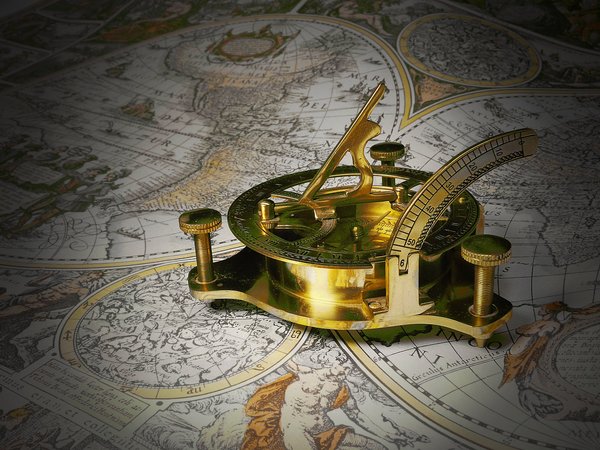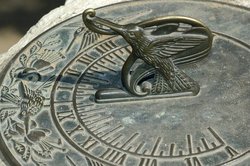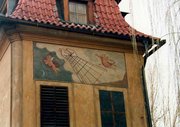Sundial
|
|
A sundial measures time by the position of the sun. The most commonly seen designs, such as the 'ordinary' or standard garden sundial, cast a shadow on a flat surface marked with the hours of the day. As the position of the sun changes, the time indicated by the shadow changes. However, sundials can be designed for any surface where a fixed object casts a predictable shadow.
Most sundial designs indicate apparent solar time. Minor design variations can measure standard and daylight saving time, as well.
Sundials are known from ancient Egypt, and were developed further by other cultures, including the Greeks and Romans.
| Contents |
|
2.1 terminology |
Installation of standard sundials
Tilting the style or gnomon of a standard sundial is the only practical way to install a mass-produced garden sundial so that it will keep time. Some mass-produced garden sundials are improperly designed, and unable to keep time. Many sundials are made to be used at 45 degrees north.
A sundial can be adjusted to another latitude by tilting it so its style or gnomon(s) is (are) parallel the Earth's axis of rotation. That is, the end of a gnomon should point at the north celestial pole in the northern hemisphere, or the south celestial pole in the southern hemisphere.
A sundial can be rotated around its style or gnomon (which must still point at the celestial pole) a maximum of 7.5 degrees to the east or west to adjust to the local standard time zone (time zones are 360 degrees/24 hours = 15 degrees wide). Tilt the sundial so that it is oriented as if it were at the longitude of the center of your local time zone.
To correct for daylight saving time, a face needs two sets of numerals or a correction table, and must be adjusted for longitude from the center of the time zone. The admittedly informal standard is to have numerals in hot colors for summer, and in cool colors for winter. Twisting the face of the sundial will not work because sundials (except at the north and south pole) do not have equal hour angles.
Ordinary sundials do not correct apparent solar time to clock time. There is a 15 minute variation through the year, known as the equation of time, because the Earth's orbit is slightly elliptical and its axis is tilted relative to the plane of its orbit. A quality sundial will include a permanently-mounted table or graph giving this correction for at least each month of the year. Some more-complex sundials have curved hour-lines, curved gnomons or other arrangements to directly display the clock time.
Design & principles of operation
terminology
The 'shadow-maker' of the sundial is called a gnomon.
The sun casts a shadow from the gnomon to a surface called the dial face or dial plate (often shortened to face).
Most sundials indicate time on the dial face by the shadow of a line in space called the style[1] (http://www.sundialsoc.org.uk/glossary/alpha.htm#S). On a standard garden sundial, this line is the top edge of the gnomon. The style should be parallel the Earth's axis of rotation. In common speech, sometimes style refers to the entire gnomon.
Some sundials indicate both the time and the date by the shadow of a particular point on the gnomon. That point is called the nodus. The nodus may be the tip of a gnomon with an arbitrary (usually horizontal or vertical) orientation[2] (http://www.sundialsoc.org.uk/glossary/alpha.htm#N).
A few sundials have both a style and a nodus, with the nodus in the form of a small sphere or a notch on a polar-pointing gnomon, or simply the tip of the gnomon.
In general, the best material for a face is a very light color to give a high contrast with the shadow. The numerals should be dark, visible on the unshaded portion of the face. The gnomon should be sturdy, preferably metal, because gnomons are usually thin, and can break easily. The traditional luxury materials are a white marble face, with markings inlaid in black marble. Traditional styles are thick bronze to prevent corrosion.
It is traditional for a sundial to have a motto.
Equatorial or Equinoctial[3] (http://www.sundials.co.uk/tbequ.htm) sundial
The simplest sundial is a disk mounted on a bar. The bar must be parallel to the Earth's axis of rotation. The disk forms a plane parallel to the plane of the Earth's equator. The disk is marked so that one edge of the shadow of the bar shows the time as the Earth rotates. Usually, noon will be at the bottom of the disk, 6AM on the western edge, and 6PM on the eastern edge. In the winter, the north side of the disk will be shaded, and hard to read. In the summer, the south side will be shaded.
In the above design, the bar is the style. The disk in the above design is called the face. In the summer, the north end of the bar is the nodus, but in the winter, the south end of the bar is the nodus.
A series of concentric circles can be drawn on the face which plot the path of the shadow of the nodus on specific days, thus the dial can be used as a calendar as well as clock. The style shows the time and the nodus the date. One disadvantage of this design is that with a solid face, near the equinox, when sun is just on the celestial equator, the dial is hard to read.
Garden sundial
The classic garden sundial uses the same principle, except the lines of the disk are projected, using trigonometry, onto a face that is parallel to the ground. The advantage of the garden sundial is that it keeps time all year, and its face is never completely shaded in the daytime (as vertical sundials are). For use in a public area, this sundial can be made visible by placing it in a square, or making the face of frosted glass, elevated high in the air, and visible from underneath. The top edge of the gnomon is parallel with the axis of the Earth's rotation. The shadow will cross time markings on the face.The markings of each edge are aligned with the edge of the gnomon that produces the shadow. The angle of the face markings from the root of the gnomon (the substyle) are calculated from the formula face-angle = arctan(sin(latitude)*tan(hour-angle)). The angle of the style (gnomon)= 90 - latitude. (See Logo programming language for a sample program to draw a garden sundial)
Vertical sundials
Although they are rare in modern life, sundials on vertical south-facing walls (north-facing in the southern hemisphere) are a traditional ancient convenience. They are easy to see from large distances and inexpensive to arrange. One sturdy method is to paint the sundial on the wall, and construct the gnomon as a tripod of metal bars. Fancy sundials used to have faces of inlaid stone.
A problem is that vertical sundials only keep time for the part of the year in which the sun illuminates the wall. They are very similar to garden sundials. The formula for a south-facing sundial face is face-angle = arctan(cos(latitude)*tan(hour-angle)). The angle of the style (gnomon)= latitude.
It used to be traditional to place four sundials on the roof or sides of a tower to provide the time. In this way, the time was available to all for the entire year. In principle, sundials can be placed on any surface, at any angle, given the correct trigonometric projection of the face. For example, sundials on roofs are harder to calculate but quite practical.
Portable sundials, for navigation and time
During the middle ages advanced yet portable astronomical instruments were developed.
Diptych sundial
One popular portable sundial design was called a diptych. It consisted of two small flat faces, joined by a hinge. Diptychs usually folded into little flat boxes suitable for a pocket. The gnomon was a string between the two faces. When the string was tight, the two faces formed both a vertical and horizontal sundial. The best material was white ivory, inlaid with black lacquer markings. The best gnomons were black braided silk, linen or hemp.
By making the two sundials have different angles to the string (and thus different projections), a diptych can be self-aligning. When both faces show the same time, the diptych shows the local apparent solar time. Additionally, the hinge will be level, and point north (in the northern hemisphere), and the diptych will be angled so the gnomon is parallel to the Earth's axis of rotation. At solar noon, sunrise and sunset, the latitude adjustment of the diptych can't affect the time of either sundial, but at 9am and 3pm, each degree of latitude error (from holding the sundial at the wrong angle) creates four minutes of difference between the two faces.
This means that a diptych can also act as a compass and even measure latitude. Some diptychs included a small scale and a plumb-bob to read the latitude. Some others included a compass rose to measure angles to geographic features. Large (meter-sized) diptychs may have been used for navigation in ancient times.
Elevation sundial
Astrolabes were used as sundials, as well as for calendrical observations, navigation and astronomy.
An even smaller design was the ring. It had a small handle, or was a fob or the decoration of a necklace. When held by its handle, a hole would cast a shadow on the inside of the ring, telling the time by markings on the inside. The user had to know if it was morning or evening. Usually, the hole was mounted in a sliding lockable piece of metal, which was adjusted to the correct date.
In recent times, U.S. Special Forces have taken to engraving a simple sundial on their knife-blade. It works even when a watch fails.
Precision sundials (heliochronometers)
A precision sundial, called a heliochronometer, corrects apparent solar time to mean solar time or another standard time. Heliochronometers usually indicate the minutes to within 1 minute of Universal Time[4] (http://www.sunlitdesign.com/infosearch/sundialaccuracy.htm).
Equatorial bow sundial
The classic shape for a heliochronometer is an equatorial bow sundial. A bar, slot or stretched wire parallel to the earth's axis forms the style. The face is a semicircle with markings on the inner surface. This pattern, built a couple of meters wide out of temperature-invariant steel invar, was used to keep the trains running on time in France before World War I.
One of the simplest sundials that reads clock time is an equatorial bow with a gnomon shaped like two vases[5] (http://www.wsanford.com/~wsanford/exo/sundials/ca/claremont/info.html). The vase-shape directly shades the hour line in the correct place as the year passes, and the sun changes elevation.
The most precise sundials ever made are monumental equatorial bows constructed of masonry by a Mogul Caliph in Jaipur, India to keep the Islamic religious calendar.
Precision noonmarks
In some older houses, particularly farmhouses, a noon-mark can be found carved into a floor or windowsill. Such marks act as sundials to indicate local noon, and they provided a simple and accurate time reference for households that did not possess accurate clocks.
In modern times, some Oriental countries' post offices have set their clocks from a precision noon-mark. These, in turn, provided the times for the rest of the society. The typical noon-mark sundial was a lens set above an analemmatic plate. The plate has an engraved figure-eight shape. When the edge of the sun's image touches the part of the shape for the current month, it is noon.
Ancient Greek sundials
The ancient Greeks used a type of sundial sometimes referred to as pelekinon (axe-like, apparently because the shape of the hour and day lines suggest the ancient double-headed ax pelekus). The gnomon was a rod or pole upright in a horizontal face or half-spherical face. The shadow of the tip of the rod sweeps out hyperbolic curves on a flat face, or circles on a spherical face. The advantage of these dials is that they can be marked to tell the exact time for all times of year.
Analemmatic sundials
Analemmatic sundials correct solar time to mean solar time or another standard time. These usually have hour lines shaped like "figure eights" (analemmas) according to the equation of time. This compensates for the slight eccentricity in the Earth's orbit that causes a 15 minute variation from mean solar time.
Very accurate dials of this type fit nicely in a public square, using a ball at the tip of a flagpole as the nodus, with the face painted on or inlaid in the pavement.
A fun, less accurate version of the sundial is to layout the hour marks on concrete, and then let the user stand in a square marked with the month. The month squares are arranged to correct the sundial for the time of year. The user's head then forms the gnomon of the dial. If the sundial is molded into the concrete, it is almost perfectly immune to vandalism, as well as truly fun and reasonably accurate.
The geometrical construction of an analemmatic sundial is simple. First, imagine an equatorial sundial floating in the air: a vertical bar directed towards the pole and a ring in the plane perpendicular to the bar. Label the lowest point of the ring "12", and the other hour marks as usual. At a certain time and date, the shadow of a certain point A on the bar (which falls here or there depending on the time of year) falls on a certain point B of the ring (which depends on the hour, and the position in the Earth's orbit). Now draw the point B' in the ground just below B and the point A' just below A. Now if you stand at A' your shadow will point at B', because the sun is somewhere in the plane A B A' B'.
In middle latitudes, the ellipse with the hour-marks should be about six meters wide, so the shadow of the head of the beholder will fall near it most of the time.
Article of Interest: “Analemmatic sundials: How to build one and why they work” by C.J. Budd and C.J. Sangwin (http://pass.maths.org.uk/issue11/features/sundials/index.html)
Reflection sundials
Isaac Newton invented a sundial for a south-facing window. He placed a tiny mirror on the windowsill, and painted the sundial's face in a mirror-image pelekinon on the ceiling and walls. The mirror formed the gnomon by reflecting a spot of light. This provides a large, accurate, perfectly correctable sundial with minimal material, and no wasted space at all. This design could easily be made analemmatic.
Analog calculating sundials
A last, interesting variation accurately keeps clock time, while still resembling a conventional garden sundial. It is a horizontal sundial with a face cut on a cardioid (a sort of heart-shape). A cardioid is the shape that connects the intersections between the solar-time marks of a conventional sundial, and the equal-angles of a true clock-time face. The place where the shadow crosses the cardioid's edge is the place where clock time can be read on the underlying clock-time dial. The sundial is adjusted for daylight saving time by rotating the underlying equal-angle clock-time face. The sun-time face does not move.
Digital sundials
A digital sundial uses light and shadow to 'write' the time in numerals (or even words), rather than marking time with position. One such design uses two parallel masks to screen sunlight into patterns appropriate for the time of day.
Reference
Sundials: Their Theory and Construction, Albert E. Waugh, Dover Publications, Inc., 1973, ISBN 0-486-22947-5.






